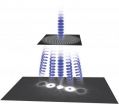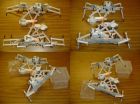(Press-News.org) Electron microscopes are among the most widely used scientific and medical tools for studying and understanding a wide range of materials, from biological tissue to miniature magnetic devices, at tiny levels of detail. Now, researchers at the National Institute of Standards and Technology (NIST) have found a novel and potentially widely applicable method to expand the capabilities of conventional transmission electron microscopes (TEMs). Passing electrons through a nanometer-scale grating, the scientists imparted the resulting electron waves with so much orbital momentum that they maintained a corkscrew shape in free space.
The development opens the possibility of adapting transmission electron microscopy, which can see tinier details than optical microscopy and can study a wider range of materials than scanning probe microscopy, for quick and inexpensive imaging of a larger set of magnetic and biological materials with atomic-scale resolution.
"The spiral shape and angular momentum of these electrons will let us look at a greater variety of materials in ways that were previously inaccessible to TEM users," said Ben McMorran, one of the authors of the forthcoming research paper. "Outfitting a TEM with a nanograting like we used in our experiment could be a low-cost way to dramatically expand the microscope's capabilities."
Although NIST researchers were not the first to manipulate a beam of electrons in this way, their device was much smaller, separated the fanned out beams 10 times more widely than previous experiments, and spun up the electrons with 100 times the orbital momentum. This increase in orbital momentum enabled them to determine that the electron corkscrew, while remarkably stable, gradually spreads out over time. The group's work was reported in the Jan. 14, 2011, issue of the journal Science.*
The corkscrewing electron beams have the potential to help obtain more information from magnetic materials, according to McMorran "Magnetism, at its most fundamental, results from charges spinning and orbiting, so an electron beam that itself carries angular momentum makes a good tool for probing magnetic materials."
This technique could also help improve TEM images of transparent objects like biological specimens. Biological material can be difficult to image in ordinary TEMs because electrons pass through it without deflecting. But by using corkscrew electron beams, researchers hope to provide high-contrast, high-resolution images of biological samples by looking at how the spiral wavefronts get distorted as they pass through such transparent objects.
While these imaging applications have not yet been demonstrated, producing corkscrew electrons with nanogratings in a TEM provides a significant step toward expanding the capabilities of existing microscopes.
INFORMATION:
For more details, read the NIST Jan. 13, 2011 news release, "NIST Puts a New Twist on the Electron Beam," at www.nist.gov/cnst/vortices_011311.cfm.
* B. McMorran, A. Agrawal, I. Anderson, A. Herzing, H. Lezec, J. McClelland and J. Unguris. Electron vortex beams with high quanta of orbital angular momentum. Science. Published Jan. 14, 2011.
Media Contact: Mark Esser, mark.esser@nist.gov, 301-975-8735
NIST puts a new twist on the electron beam
2011-01-21
ELSE PRESS RELEASES FROM THIS DATE:
Study yields better turbine spacing for large wind farms
2011-01-21
Large wind farms are being built around the world as a cleaner way to generate electricity, but operators are still searching for the most efficient way to arrange the massive turbines that turn moving air into power.
To help steer wind farm owners in the right direction, Charles Meneveau, a Johns Hopkins fluid mechanics and turbulence expert, working with a colleague in Belgium, has devised a new formula through which the optimal spacing for a large array of turbines can be obtained.
"I believe our results are quite robust," said Meneveau, who is the Louis Sardella ...
Are positive emotions good for your health in old age?
2011-01-21
The notion that feeling good may be good for your health is not new, but is it really true? A new article published in Current Directions in Psychological Science, a journal of the Association for Psychological Science, reviews the existing research on how positive emotions can influence health outcomes in later adulthood.
"We all age. It is how we age, however, that determines the quality of our lives," said Anthony Ong of Cornell University, author of the review article. The data he reviews suggest that positive emotions may be a powerful antidote to stress, pain, ...
With chemical modification, stable RNA nanoparticles go 3-D
2011-01-21
CINCINNATI—For years, RNA has seemed an elusive tool in nanotechnology research—easily manipulated into a variety of structures, yet susceptible to quick destruction when confronted with a commonly found enzyme.
"The enzyme RNase cuts RNA randomly into small pieces, very efficiently and within minutes," explains Peixuan Guo, PhD, Dane and Mary Louise Miller Endowed Chair and professor of biomedical engineering at the University of Cincinnati (UC). "Moreover, RNase is present everywhere, making the preparation of RNA in a lab extremely difficult."
But by replacing a ...
Louisiana Tech University professor visits India as part of US delegation on energy issues
2011-01-21
RUSTON, La. – While most people were busy shopping during the holiday season, Dr. Daniela Mainardi, associate professor of chemical engineering at Louisiana Tech University and member of the Institute for Micromanufacturing, was preparing for a trip that would take her half way around the world.
As part of a joint effort, Mainardi, together with Virendra Mathur from the University of New Hampshire, and Suddhasatwa Basu and Shantanu Roy from The Indian Institute of Technology-Delhi, was in charge of organizing a workshop titled, "Energy and Environment: Challenges and ...
Latest American Chemical Society podcast: Biodegradable foam from milk protein and clay
2011-01-21
WASHINGTON, Jan. 20, 2011 — The latest episode in the American Chemical Society's (ACS) award-winning podcast series, "Global Challenges/Chemistry Solutions," focuses on development of a new ultra-light biodegradable foam plastic material made from two unlikely ingredients: The protein in milk and ordinary clay.
The material could be used in numerous products, researchers report in the ACS' Biomacromolecules, a monthly journal. The finding comes amid ongoing concern about plastic waste accumulating in municipal landfills, and reliance on imported oil to make plastics.
David ...
Scripps Research scientists find measles' natural nemesis
2011-01-21
LA JOLLA, CA – January 20, 2011 – Scientists at The Scripps Research Institute have found that a known enzyme in cells protects against measles virus, likely by altering the virus's genetic material, RNA. Cells lacking the enzyme become highly vulnerable to the virus's destructive effects. The enzyme also protects against several other respiratory viruses, including influenza A.
"We believe that host cells use this RNA-editing enzyme to slow these viruses' ability to replicate," said Michael B. A. Oldstone, the study's senior author and a professor at Scripps Research's ...
War, plague no match for deforestation in driving CO2 buildup
2011-01-21
Stanford, CA— Genghis Khan and his Mongol hordes had an impact on the global carbon cycle as big as today's annual demand for gasoline. The Black Death, on the other hand, came and went too quickly for it to cause much of a blip in the global carbon budget. Dwarfing both of these events, however, has been the historical trend towards increasing deforestation, which over centuries has released vast amounts of carbon dioxide into the atmosphere, as crop and pasture lands expanded to feed growing human populations. Even Genghis Kahn couldn't stop it for long.
"It's a common ...
Insect eyes inspire improved solar cells
2011-01-21
WASHINGTON, Jan. 20 – The eyes of moths, which allow them to see well at night, are also covered with a water-repellent, antireflective coating that makes their eyes among the least reflective surfaces in nature and helps them hide from predators in the dark. Mimicking the moth eye's microstructure, a team of researchers in Japan has created a new film, suitable for mass-production, for covering solar cells that can cut down on the amount of reflected light and help capture more power from the sun.
In a paper appearing in Energy Express (www.OpticsInfoBase.org/ee), a ...
For robust robots, let them be babies first
2011-01-21
VIDEO:
A two-minute video, "Morphological Change in Machines Accelerates the Evolution of Robust Behavior, " was produced by the Morphology, Evolution and Cognition Laboratory, University of Vermont, 2011.
Click here for more information.
Want to build a really tough robot? Forget about Terminator. Instead, watch a tadpole turn into a frog.
Or at least that's not too far off from what University of Vermont roboticist Josh Bongard has discovered, as he reports ...
Gene test shows which bladder cancer patients may have cancer spread
2011-01-21
AURORA, Colo. (Jan. 20, 2011)--Cancer scientists have designed the first molecular test to predict which bladder cancer patients may have cancer involvement in their lymph nodes at the time of surgery—which could help doctors determine which patients are good candidates for pre-surgical, or neo-adjuvant, chemotherapy.
The test analyzes 20 genes on tumor biopsies, according to a paper published online Jan. 20, 2011, in Lancet Oncology.
"Randomized clinical trials have shown that giving neo-adjuvant chemotherapy extends patient lives, but only 5 to 15 percent of patients ...


